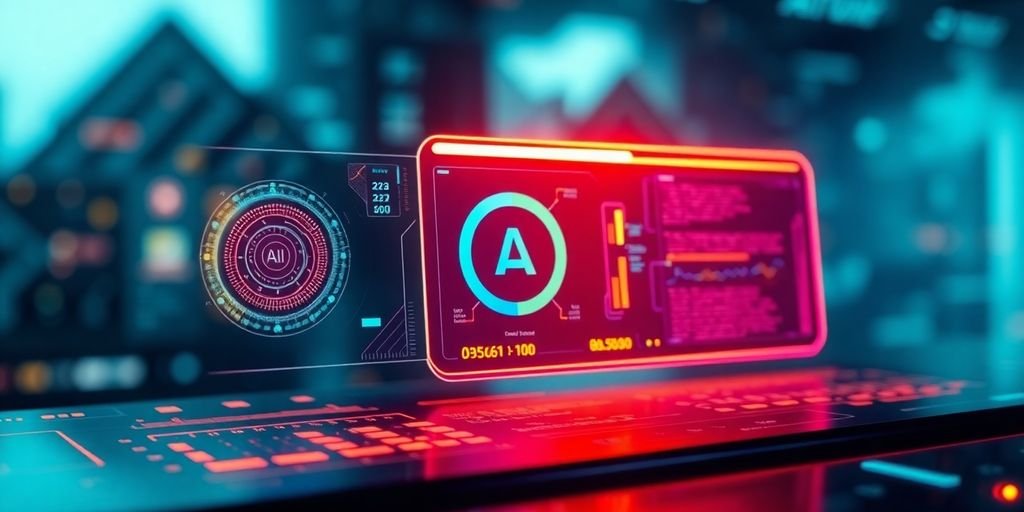AI detection tools are becoming increasingly important in our digital world. As artificial intelligence continues to evolve, the need for reliable detection methods grows. One standout tool in this space is zerogpt.in, which has gained attention for its effectiveness in identifying AI-generated content. In this article, we will explore the technology behind AI detection, take a closer look at zerogpt.in, compare it with other tools, and discuss its applications and future trends.
Key Takeaways
- Zerogpt.in is recognized for its accuracy in detecting AI-generated content.
- Understanding how AI detection tools work is essential for their effective use.
- AI detection tools have significant applications in education, content creation, and legal contexts.
- Comparing different AI detection tools can help users choose the best fit for their needs.
- Future advancements in AI detection technology will likely focus on improving accuracy and user trust.
Understanding AI Detection Technology

How AI Detectors Work
Okay, so how do these AI detectors actually work? Basically, they look for patterns. AI writing often has a certain… predictability to it. Detectors analyze things like sentence structure, word choice, and how likely certain words are to follow each other. It’s all about probability and spotting the difference between human writing’s quirks and AI’s more structured output.
Key Features of AI Detection Tools
When you’re checking out AI detection tools, here are some things to keep in mind:
- Accuracy: Does it get it right most of the time?
- Explanation: Does it tell you why it thinks something is AI-generated?
- Speed: How fast does it give you results?
- Supported file types: Can it handle different kinds of documents?
Importance of Accurate Detection
Why does accurate AI detection even matter? Well, there are a bunch of reasons. In education, it’s about making sure students are doing their own work. In content creation, it’s about maintaining originality and avoiding plagiarism. And in general, it’s about being able to tell what’s real and what’s not in a world where AI-generated content is becoming more and more common.
It’s important to remember that no AI detector is perfect. They can make mistakes, and AI models are constantly evolving to get better at mimicking human writing. So, it’s always a good idea to use these tools as a guide, not as the final word.
Exploring Zerogpt.in
Overview of Zerogpt.in
Zerogpt.in has become a notable player in the AI detection field. It’s designed to help users determine if text was generated by AI or written by a human. The platform offers a range of tools beyond just detection, aiming to assist with content creation, analysis, and optimization. It’s a service that’s trying to be more than just a one-trick pony. You can use advanced AI tools for various tasks.
Unique Features of Zerogpt.in
Zerogpt.in brings a few interesting things to the table. It’s not just about spotting AI-generated text; it also includes features to help humanize AI content, which is pretty cool. Here’s a quick rundown:
- AI Content Detection: Identifies text generated by AI models.
- Text Humanization: Modifies AI-generated text to sound more human.
- Text-to-Speech: Converts text into spoken words.
Zerogpt.in seems to be focusing on providing a suite of tools that cater to different needs, from ensuring originality to making AI-generated content more engaging. It’s an interesting approach that sets it apart from some of the more basic AI detectors out there.
User Experience and Interface
Using Zerogpt.in is pretty straightforward. The interface is clean, and it’s easy to upload or paste text for analysis. I found the results to be displayed quickly, which is always a plus. It’s a pretty standard SaaS service, complete with pricing, company name, and contact information. The service seems to work fairly well. You can also detect up to 2,0000 characters with the free version.
Comparative Analysis of AI Detection Tools
Zerogpt.in vs. Competitors
Okay, so let’s get into how Zerogpt.in stacks up against the other AI detectors out there. It’s a crowded market, and everyone’s claiming to be the best, right? Zerogpt.in definitely has some things going for it, but it’s not perfect. You’ve got big names like Originality.ai and GPTZero that have been around for a while, and then newer tools popping up all the time. The key is understanding what each tool is good at. Some are better at detecting certain types of AI writing, while others might be more accurate overall. It really depends on what you’re looking for.
Strengths and Weaknesses
Every AI detector has its pluses and minuses. Zerogpt.in might be super user-friendly, but maybe it’s not as accurate as something like Copyleaks, which claims high accuracy. On the flip side, Copyleaks might give you a ton of false positives, flagging human-written text as AI. It’s a balancing act.
Here’s a quick rundown:
- Zerogpt.in: Easy to use, potentially faster, but accuracy might vary.
- GPTZero: Known for its focus on educational content, but can be a bit sensitive.
- Originality.ai: Often considered more accurate, but can be pricier.
It’s important to remember that no AI detector is foolproof. They all have limitations, and relying solely on one tool can be risky. Always double-check the results and use your own judgment.
User Reviews and Feedback
What are people actually saying about these tools? User reviews can be super helpful, but you’ve gotta take them with a grain of salt. Some people might have had a bad experience because they didn’t understand how to use the tool properly. Others might be biased for whatever reason. Look for common themes in the reviews. Are people consistently saying that Zerogpt.in is easy to use but sometimes misses AI-generated content? Or are they saying that another tool is super accurate but way too expensive? That kind of feedback can give you a better sense of what to expect. Also, keep an eye out for reviews that mention specific use cases. Someone using the tool for academic work might have different needs than someone using it for marketing content. Ultimately, the best way to find out which tool works best for you is to try a few out and see for yourself. Don’t just rely on what other people say. Consider undetectable AI as well, as Forbes has ranked it as the best AI detector.
Applications of AI Detection Tools

Educational Use Cases
AI detection tools are becoming really important in education. Teachers and professors are using them to check if students are submitting work written by AI, like ChatGPT. It’s not about stopping students from using AI altogether, but more about making sure they’re still learning and doing their own thinking. Schools want to maintain academic integrity, and these tools help with that. It’s a tricky balance, though, because you don’t want to accuse someone unfairly.
- Checking essays and assignments
- Monitoring online exams
- Promoting original thought
Content Creation and Marketing
In the world of content, originality is king. AI detection tools help make sure the content you’re putting out there is actually yours. If you’re paying someone to write blog posts or articles, you want to know they’re not just feeding prompts into an AI and calling it a day. These tools can also help you avoid accidentally publishing something that’s too similar to existing content, which could hurt your search engine rankings. Using AI detection bot can help maintain content quality.
It’s not just about avoiding plagiarism; it’s about building trust with your audience. People can tell when something feels generic or AI-generated, and that can damage your brand.
Legal and Ethical Implications
AI-generated content is raising some serious legal and ethical questions. Who owns the copyright to something written by an AI? If an AI writes something defamatory, who’s responsible? AI detection tools can help sort through these issues by identifying AI-generated text. This is especially important in fields like journalism and law, where accuracy and accountability are crucial. It’s a new area, and the rules are still being written, but these tools are playing a big part in shaping the conversation.
Here’s a quick look at some of the legal and ethical considerations:
- Copyright ownership
- Liability for misinformation
- Transparency in AI use
Future Trends in AI Detection
Advancements in Detection Algorithms
AI detection is a moving target. As AI writing and image generation get better, so too must the tools designed to spot them. We’re likely to see detection algorithms that are far more nuanced, able to pick up on subtle tells that current tools miss. Think about it: right now, many detectors look for predictable sentence structures or word choices. The next generation will probably analyze things like emotional tone, argumentation style, and even the underlying logic of the text. It’s going to be a constant arms race, with AI and AI detection tools pushing each other to evolve. The future of AI is here, and it’s complicated.
Integration with Other Technologies
Imagine AI detection not as a standalone tool, but as a feature baked into other platforms. That’s where things are headed. We could see it integrated into word processors, content management systems, and even social media platforms. For example, a word processor might flag potentially AI-generated text in real-time, or a social media site might use AI detection to combat bots and fake news. This integration will make AI detection more seamless and accessible, but it also raises questions about privacy and censorship.
Predictions for 2025 and Beyond
Looking ahead, here are a few predictions for the AI detection landscape:
- Increased Accuracy: Expect significant improvements in accuracy, with fewer false positives and negatives. The best AI detectors comparison table will be updated frequently.
- Deepfake Detection: Tools will expand beyond text to detect AI-generated images, audio, and video (deepfakes) more effectively.
- Real-time Verification: Real-time AI verification tools will become more common, allowing users to check content as it’s being created or consumed.
The challenge will be balancing the need for accurate detection with the potential for misuse. As AI becomes more sophisticated, so too must our approach to detecting it. It’s not just about identifying AI-generated content, but about understanding its impact on society and developing responsible ways to use and regulate it.
Challenges in AI Detection
Evolving AI Models
AI is changing fast, and that’s a big problem for AI detection. What works today might not work tomorrow. It’s like trying to hit a moving target. The models that generate text are constantly getting better at sounding human, which means detectors have to keep up. This requires constant updates and new approaches. It’s a never-ending game of cat and mouse.
False Positives and Negatives
One of the biggest headaches with AI detection is that it’s not always right. You get false positives, where the tool says something was written by AI when it was actually written by a human. And you get false negatives, where AI-generated text slips right through. This can cause real problems, especially in education or content creation. Imagine getting accused of using AI when you didn’t! It erodes trust in the tools and makes people question the results. It’s important to remember that these tools are not perfect and should be used with caution. For example, accuracy issues can arise.
User Trust and Transparency
If people don’t trust an AI detection tool, they won’t use it. And trust is hard to earn, especially when the technology is complex and the results can be uncertain. Transparency is key. Users need to understand how the tool works, what its limitations are, and how to interpret the results. If a tool just gives a score without explaining why, people are less likely to believe it. It’s also important to be upfront about the possibility of errors. No tool is perfect, and acknowledging that can actually build more trust in the long run.
It’s important to remember that AI detection is not a perfect science. There will always be challenges and limitations. The key is to use these tools responsibly and to understand their strengths and weaknesses.
Best Practices for Using AI Detection Tools
Maximizing Accuracy
Okay, so you’re using an AI detection tool. Cool. But are you really using it right? Getting the most accurate results isn’t always as simple as just uploading text and hitting ‘scan’. Think of these tools like a weather forecast – they give you an idea, but they aren’t always spot-on. Here’s how to boost your chances of getting it right:
- Use High-Quality Input: Garbage in, garbage out. Make sure the text you’re checking is clean and properly formatted. Messy formatting can throw things off.
- Adjust Sensitivity Settings: Most tools let you tweak how sensitive they are. Play around with these settings to see what works best for your type of content. Start with the default, then adjust up or down based on your initial results.
- Consider the Context: AI detectors aren’t mind readers. They don’t know the context of the writing. If you’re checking something technical or niche, it might flag things that are actually legit.
Remember, no AI detector is perfect. Always use your own judgment to double-check the results. Don’t blindly trust the tool; think critically about what it’s telling you.
Combining Tools for Better Results
One AI detection tool might miss something that another catches. It’s like getting a second opinion from a doctor. Using multiple tools can give you a more complete picture. Think of it as a layered defense against AI-generated content. Here’s a simple strategy:
- Run the text through Zerogpt.in AI detection first.
- Then, try another tool like GPTZero or Originality.ai.
- Compare the results. If both tools flag the same sections, there’s a higher chance it’s AI-generated.
Staying Updated with Technology
AI is evolving at warp speed, and so are the tools that detect it. What worked last month might not work today. Staying updated is key. Here’s how to keep up:
- Read Blogs and Articles: Follow tech blogs and publications that cover AI detection. They often review new tools and techniques.
- Join Forums and Communities: Online forums and communities are great places to learn from other users and share tips. Plus, you’ll hear about new developments faster.
- Experiment Regularly: Don’t just stick with the same old tools. Try out new ones as they come along. See how they perform and whether they offer any advantages over what you’re already using.
Wrapping It Up
In conclusion, the landscape of AI detection tools is evolving fast, and it’s clear that tools like Undetectable AI are leading the pack. With features that go beyond just spotting AI-generated content, they offer a range of utilities that can really help users. Whether you’re a student, a professional, or just someone curious about AI, having a reliable detector is becoming more important. As AI continues to grow, so will the need for these tools. So, if you haven’t already, it might be time to check out one of these advanced detectors and see how they can work for you.
Frequently Asked Questions
What is an AI detector?
An AI detector is a tool that checks if a piece of text or an image was made by artificial intelligence (AI) programs like ChatGPT or Bard. It looks at patterns and sentence structures to figure this out.
How do AI detectors work?
AI detectors analyze the way words are used and the structure of sentences. They use special algorithms to check if the content seems like it was written by a human or generated by AI.
Why is it important to use AI detection tools?
Using AI detection tools is important because they help ensure the authenticity of content. This is especially useful in schools and businesses to prevent cheating or misinformation.
What are some popular AI detection tools?
Some popular AI detection tools include AI Detector, Winston AI, and Undetectable AI. Each has its own unique features and strengths.
Can AI detectors check images and videos?
Yes, some AI detectors can also analyze images and videos to see if they were created by AI, not just text.
What challenges do AI detection tools face?
AI detection tools face challenges like keeping up with new AI models, dealing with false positives (wrongly identifying human content as AI), and building trust with users.




Pingback: Best AI Detectors for Teachers & Schools (Free Tools) - blog.zerogpt.in
Pingback: Shocking Truth: Can Turnitin Detect AI-Generated Essays? (2025 Update) - blog.zerogpt.in